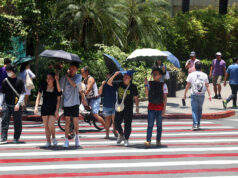Full gov’t mobilization urged for Laguna de Bay
THE Management Association of the Philippines (MAP) said President Rodrigo R. Duterte needs to issue an executive order broadly mobilizing government agencies to work toward the rehabilitation of the Laguna de Bay.
In a statement, MAP cited as a model government efforts to clean up Boracay Island and called for a similar level of commitment to preserve Laguna de Bay for water security and eco-tourism.
“We urge PRRD to take similar action… and order a Save Laguna Lake action by issuing an Executive Order to direct all national and local government units and instrumentalities to immediately implement all existing laws, rules, regulations and directives to protect and rehabilitate Laguna Lake and the forest cover of its watershed in the surrounding hills and mountains,” MAP said.
MAP also urged Mr. Duterte to direct the national and local water boards to tap Laguna de Bay as a “dependable, inexhaustible and proximately-located source of raw water for Metro Manila and the lake’s surrounding communities, with other sources such as dams serving a complementary role to ensure water security under all circumstances, including potentially catastrophic earthquakes.”
“Further, that all resources, including funding from whatever source, be devoted for the said purpose,” MAP added.
MAP said Laguna de Bay has “continuously degenerated from neglect and wanton disregard for the lake’s well-being much like other natural resources of our country.”
“The public must be warned that the government will strictly enforce existing laws that prohibit, under pain of penalty, the dumping of waste into the lake,” MAP added.
As such, the group recommended the imposition of strict regulations on polluting industries, including factories, aquaculture, poultry and livestock farms.
MAP also called for a ban on the use of vessels powered by fossil fuel, adding some countries have adopted policies allowing only vessels running on clean energy in certain waters.
MAP also urged the imposition of a no-build zone starting from the high-water mark stretching back no less than fifty meters inland, especially in populated areas, to allow space for public recreation and enjoyment of the national resource.
The group also pointed the need for massive reforestation in the lake’s surrounding hills and mountains to enhance the productivity of the watershed with the sustainable utilization of indigenous wood species, fruit-bearing trees and bamboo.
MAP also requested Mr. Duterte to direct the Department of Transportation to plan and implement a lake ferry system to provide convenient, affordable and reliable connectivity between the towns and cities along the shoreline.
It asked the Department of Tourism to plan, develop and implement eco-tourism projects to fully exploit the lake’s potential, and for the Biodiversity Management Bureau, an attached unit of the Environment Department, to recommend public recreational parks for implementation and maintenance of various agencies. It proposed to name its campaign the Save Laguna Lake Movement, inviting broad-based support from all sectors.
“Ideally, this Movement should be adopted by private corporations as among their primary social responsibility projects. Civil society, including all environment protection organizations, are stakeholders and must participate,” it said, proposing that the recommended rehabilitation model for Laguna de Bay be replicated in the preservation of all freshwater lakes in the Philippines. — Janina C. Lim



